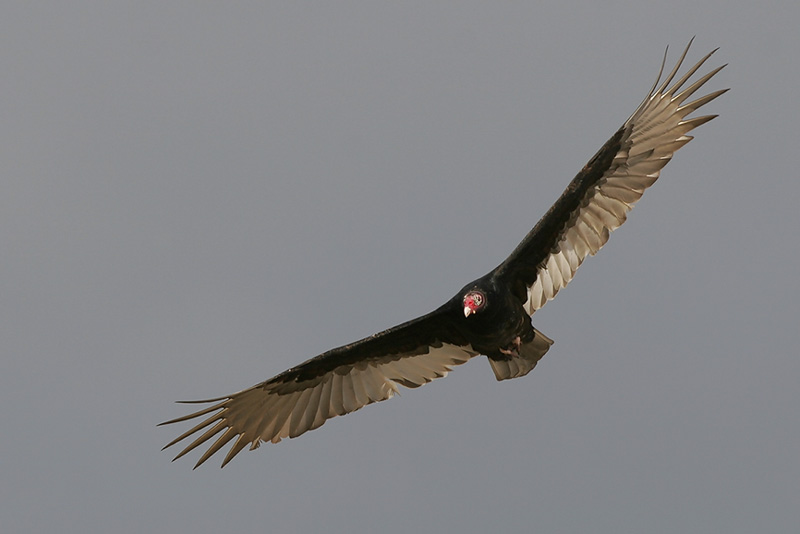
Identifying birds in flight has its own set of challenges. These include:
- Bird may be seen for a short period of time
- Colors not obvious
- Shape can change depending on situation. For example, the tail feathers may or may not be spread.
Hawks, eagles and vultures are often observed soaring, and certain characteristics can help narrow down your choices. In soaring birds, shape and relative areas of light and dark are good clues. With experience, the way a bird flies will often reveal its identity.
New World Vultures – Family Cathartidae
Turkey Vulture
Cathartes aura
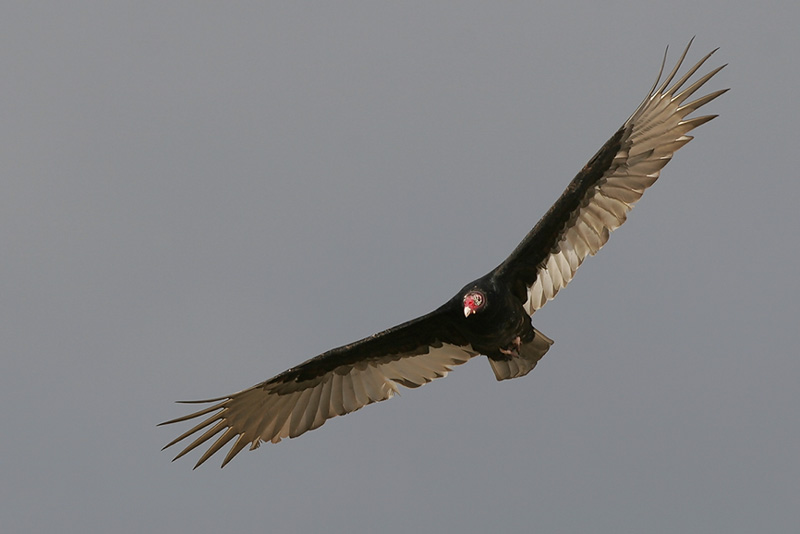
- Length: 24-32 inches
- Wingspan: 63-72 inches
Turkey Vultures, second only to eagles and condors in terms of size, are impressive raptors. They have a black body, and the underside of their wings is uniformly gray, giving them a two-toned appearance.
The dark plumage is contrasted by their naked, strikingly red head. Adding to their distinct appearance, their long and broad wings end with finger-like feathers that aid them in maneuvering.
When soaring through the air, Turkey Vultures hold their wings in a distinct V-shape with their wings slightly raised.
Moreover, their long tails extend beyond their feet, which gives them an elongated appearance. They rarely flap and their flight can be described as teetering.
If you happen to spot Turkey Vultures, you might find them gliding relatively close to the ground, diligently scanning for carrion. However, they are also known to soar to higher altitudes, utilizing thermals to their advantage.
These vultures tend to soar and gather in small groups, frequently congregating around roadkill.
Black Vulture
Coragyps atratus
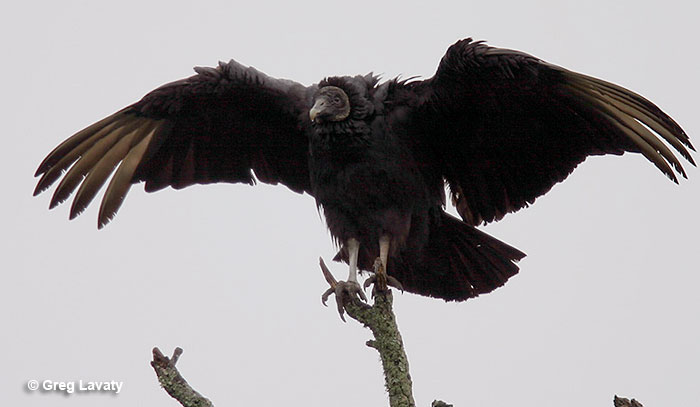
- Length: 22-29 inches
- Wingspan: 52-66 inches
Black Vultures are very large birds, just slightly smaller than Turkey Vultures. Unlike Turkey Vultures, their plumage is entirely black, except for distinct white patches on the underside of their wingtips. Additionally, their heads are small and black in color.
Similar to Turkey Vultures, they also have finger-like feathers at the tips of their wings.
In flight, they hold their broad, rounded wings flat and slightly angled forward. They soar steadily and rarely flap. Compared to Turkey Vultures, their tails are shorter and more rounded.
To spot Black Vultures, look for them in open areas within forested landscapes. During daylight hours, they often soar in flocks, frequently accompanied by Turkey Vultures and hawks. W
hile they share a dark plumage with Turkey Vultures, Black Vultures lack the two-toned appearance of their counterparts. Additionally, the white patches on the underside of the wingtips are unique to Black Vultures and absent in Turkey Vultures.
Hawks, Kites, Eagles – Family Accipitridae
Bald Eagle
Haliaeetus leucocephalus
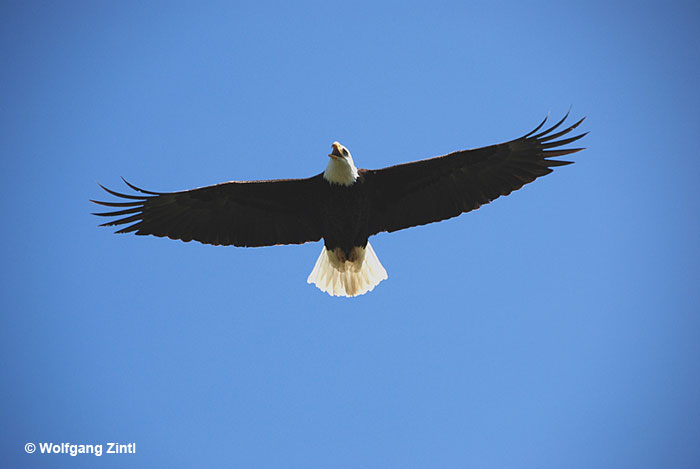
- Length: 28-40 inches
- Wingspan: 5 ft 11 in – 7 ft 7 in
The Bald Eagle is a massive raptor. Adult Bald Eagles are easily recognizable by their distinctive white heads and tail that create a striking contrast against their dark brown bodies and wings. I
mmature Bald Eagles are a bit harder to recognize – they have a dark overall plumage with varying amounts of white mottling. However, immatures always have a dark band at the end of the tail.
In flight, Bald Eagles have wedge-shaped tails, very long and broad wings that they hold fairly flat, and slots between primary feathers, allowing for steady flight. They are built for soaring and use wind corridors whenever possible.
Golden Eagle
Aquila chrysaetos
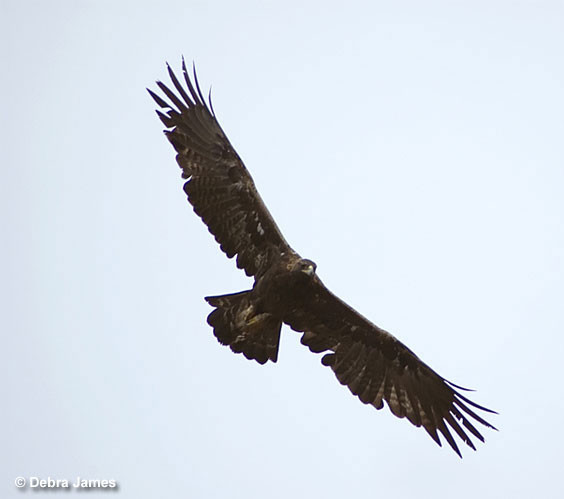
- Length: 26-40 inches
- Wingspan: 5 ft 11 in – 7 ft 8 in
The Golden Eagle is one of the biggest in North America, along with the Bald Eagle. Adults are dark brown all over with a golden sheen on the back of their head and neck and slightly paler flight feathers, although not as contrastingly so as the two-toned Turkey Vulture.
Immatures are dark brown with white oval-shaped patches on the primary flight feathers and a white patch at the base of the tail. It is very easy to confuse them for immature Bald Eagles, but these white oval-shaped patches on their wings are a clear indicator that it’s an immature Golden Eagle.
In flight, Golden Eagles have long and broad wings. When you observe them from a distance, you’ll notice a relatively small head and a long tail that extends farther behind than the head protrudes in front.
These majestic birds are typically seen alone or in pairs, often soaring or gliding with their wings lifted into a slight “V” shape, although not as much so as the Turkey Vulture.
They have narrower wings than the Bald Eagle and are surprisingly agile, capable of making sharper turns than other raptors of that size.
Sharp-shinned Hawk
Accipiter striatus
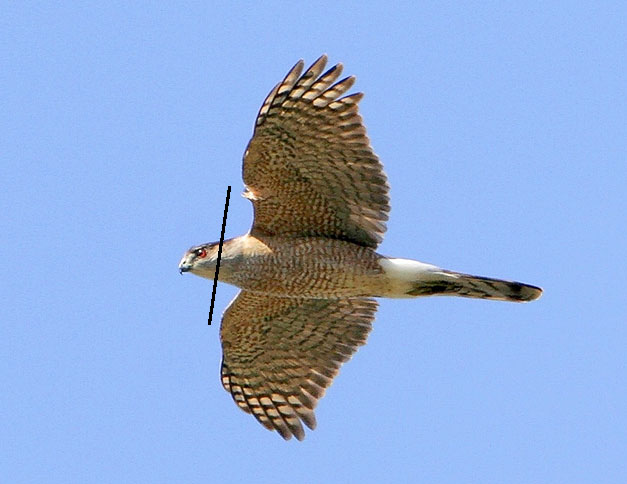
- Length: 9-15 inches
- Wingspan: 17-27 inches
The Sharp-shinned Hawk, commonly referred to as a Sharpie, is one of the three Accipiters found in North America. They’re commonly found within dense conifer or mixed forests during the breeding season and can be seen in semi-open habitats during the winter.
Adults have a slaty-blue upperside while their chest and wing linings are barred in rufous and white.
When in flight, you can see that they have short, broad, and rounded wings, with noticeable slots between the primary feathers and long, often squared or notched tails. Their flight feathers and tails are barred dark brown and white, and the tail is tipped in white.
Similar to other Accipiters, they have a flap-flap-glide flight pattern. However, they flap their wings more rapidly compared to others and may appear unsteady in windy conditions. It’s worth noting that when observing Sharp-shinned Hawks, an important feature to focus on is the head projection.
Their heads don’t always extend beyond the “wrists” of their wings, which helps in differentiating them from other similar species.
Cooper’s Hawk
Accipiter cooperii
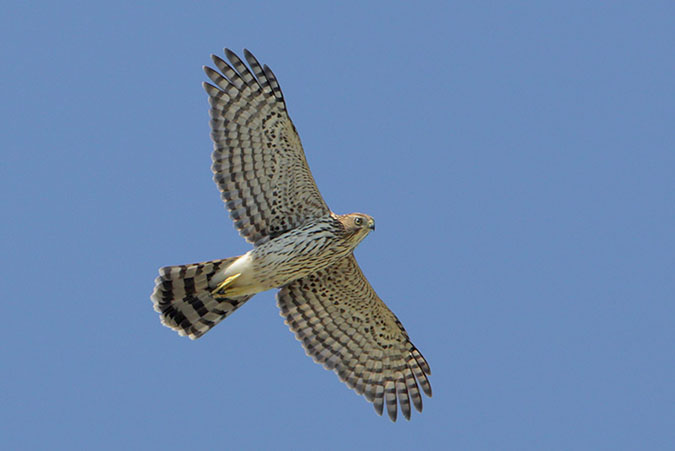
- Length: 14-20 inches
- Wingspan: 24-39 inches
The Cooper’s Hawk, similar in appearance to the Sharp-shinned Hawk, poses a challenge when it comes to identification due to their nearly identical plumage. They inhabit similar, although on average slightly more open forests and woodlands, even well-wooded suburbs, preferring deciduous to coniferous forests.
In terms of size, Cooper’s Hawks are generally larger compared to Sharp-shinned Hawks, although female Sharp-shinned Hawks can reach a similar size as male Cooper’s Hawks.
One distinguishing feature is the squared shape of their heads. Additionally, the barring on adult Cooper’s Hawks appears finer and more regular. When in flight, Cooper’s Hawks follow a similar flight pattern of flap-flap-glide.
However, they tend to fly on more deliberate and powerful wingbeats, with longer glides in between. Their tails are commonly rounded, rather than squared or notched.
Red-tailed Hawk
Buteo jamaicensis

- Length: 18-26 inches
- Wingspan: 45-52 inches
Red-tailed Hawks, one of the most common hawks in North America, are known for their iconic raspy scream used in almost every Hollywood movie no matter the raptor species.
This species has 14 recognized subspecies and three morphs with colors ranging from light auburn to deep brown. Typically, though, the underside of their flight feathers are lighter than the rest of their body and most subspecies showcase a rust-colored tail, hence the name.
Red-tailed Hawks have large, rounded wings that appear muscular.
It is common to spot them soaring gracefully in wide circles high above a field or perched atop trees or tall poles.
Rough-legged Hawk
Buteo lagopus
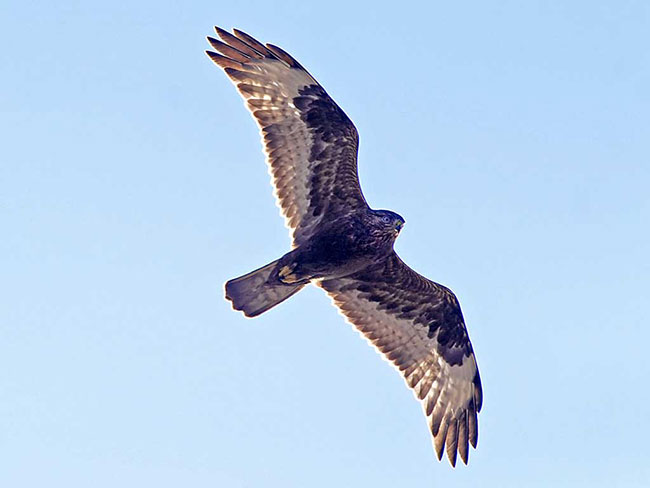
- Length: 18-21 inches
- Wingspan: 52-54 inches
Rough-legged Hawks have both light and dark morphs. Female adult light morphs have pale breasts, a black patch on their bellies, a light head, and a white tail with a black tip.
Male light morphs look similar but are more mottled with white. In flight, however, the black patches at the wrist are a certain tell no matter the sex of the bird.
Dark morphs are two-toned – they have dark bodies, wing linings, and tails and white pale flight feathers with dark trailing and white bands in the tail.
Rough-legged Hawks are commonly found in open country, where they hunt for prey. They fly on easy wingbeats and are less inclined to soar compared to other raptors, turning into the wind and flapping to hover in place. They may also perch on the ground.
Northern Harrier
Circus hudsonius
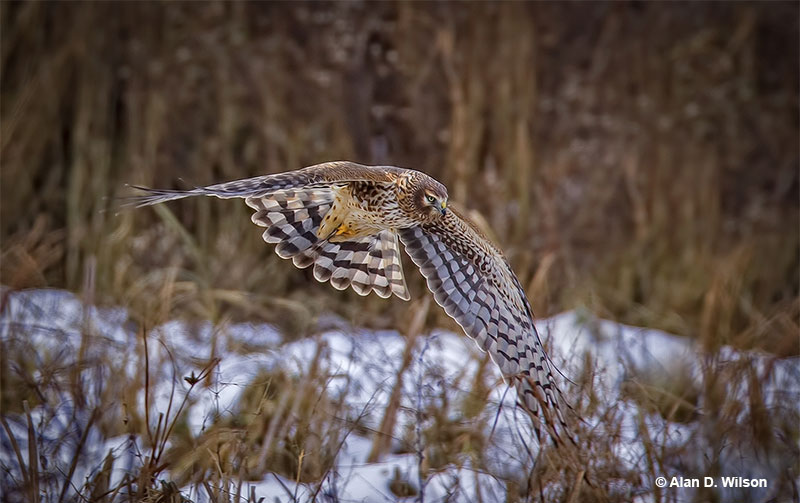
- Length: 16-20 inches
- Wingspan: 38-48 inches
Northern Harriers are medium-sized raptors characterized by their long and broad wings and long and rounded tails. Their faces are similar to that of an owl.
When in flight, these harriers can be observed quartering low and slow or even hovering over grassy or marshy habitats. They hold their wings in a distinctive V-shape.
Male Northern Harriers have grayish uppersides and whitish undersides, with a dark trailing edge to their wings and a black-banded tail. In contrast, females have paler undersides streaked in brown.
Regardless of gender, all Northern Harriers showcase a distinctive white rump patch.
